
- •Введение
- •INTRODUCTION
- •Architecture as a scientific discipline
- •Cathedrals and great churches
- •A cathedral
- •Abbey
- •Belfry
- •Chapel
- •Baptistery
- •Monastery
- •Parts of religious architectural ensemble
- •CITY ARCHITECTURAL OBJECTS
- •Megalopolis
- •Street
- •Boulevard
- •Plaza
- •City block
- •Guard rail
- •Terrace
- •Race course
- •Viaduct
- •Interchange (road)
- •Town hall
- •Tower
- •Museum
- •Amphitheatre
- •Bridge
- •Causeway
- •ORNATE ARCHITECTURAL OBJECTS
- •Park
- •Pavilion
- •Grotto
- •Fountain
- •HISTORICAL ARCHITECTURAL OBJECTS
- •Fire tower
- •Kremlin
- •Fortress
- •Barn
- •Izba
- •Log house
- •Presidio
- •Redoubt
- •Bastion
- •Palace
- •Castle
- •ELEMENTS OF A CASTLE
- •RESIDENTIAL STRUCTURES
- •Villa, cottage
- •Exterior
- •Veranda
- •Roof
- •Balustrade
- •Balcony
- •Parapet
- •Portico
- •Spire
- •Facade
- •INTERIOR
- •Basement
- •Hall
- •Enfilade
- •Attic
- •Staircase
- •Gallery
- •Mezzanine
- •Storey
- •Библиографический список
in countries where wooden buildings are prevalent. They are often clad in metal, such as copper or lead. They may also be tiled or shingled.
Clad spires can take a variety of shapes. These include:
Pyramidal spires, which may be of low profile, rising to a height not much greater than its width, or, more rarely, of high profile.
Rhenish helm: This is a four-sided tower topped with a pyramidal roof each of the four sides of the roof is rhomboid in form, with the long diagonal running from the apex of roof to one of the corners of the supporting tower; each side of the tower is thus topped with a gable from whose peak a ridge runs to the apex of the roof.
Broached spires: These are octagonal spires sitting on a square tower, with sections of spire rising from each corner of the tower, and bridging the
spaces between the corners and four of the sides. |
И |
Bell-shaped spires: These spires, sometimes square in plan, occur mostly in Northern, Alpine and Eastern Europe, where they occur alternately with
onion-shaped domes.
FacadeД
A facade or façade is generallyАone exterior side of a building, usually, but not always, the front. Theбword comes from the French language, literally meaning "frontage" or "face".
In architecture, theиfacade of a building is often the most important aspect from a design standpoint, as it sets the tone for the rest of the building. From the engineering perspectiveСof a building, the facade is also of great importance due to its impact on energy efficiency. Many facades are historic, and local zoning regulations or other laws greatly restrict or even forbid their alteration.
In modern highrise buildings, the exterior walls are often suspended from the concrete floor slabs. Examples include curtain walls and precast concrete walls. The facade can at times be required to have a fire-resistance rating, for instance, if two buildings are very close together, to lower the likelihood of fire spreading from one building to another.
In general, the facade systems that are suspended or attached to the precast concrete slabs will be made from aluminium (powder coated or anodized) or stainless steel. In recent years more lavish materials such as titanium have sometimes been used, but due to their cost and susceptibility to panel edge staining these have not been popular.
Whether rated or not, fire protection is always a design consideration. The melting point of aluminium, 660 °C, is typically reached within minutes of the start of a fire. Firestops for such building joints can be qualified, too. Putting
128
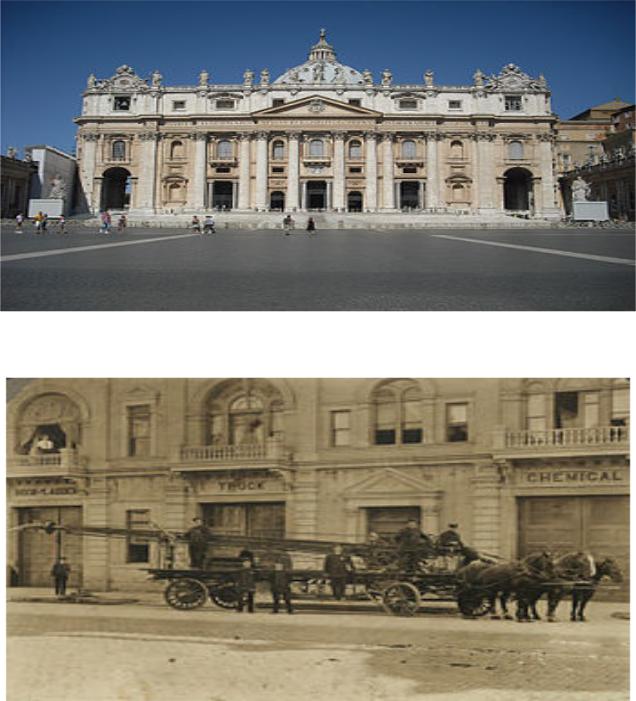
fire sprinkler systems on each floor has a profoundly positive effect on the fire safety of buildings with curtain walls.
Some building codes also limit the percentage of window area in exterior walls. When the exterior wall is not rated, the perimeter slab edge becomes a junction where rated slabs are abutting an unrated wall. For rated walls, one may also choose rated windows and fire doors, to maintain that wall's rating (рис. 189, 190).
|
|
|
И |
|
|
Д |
|
|
А |
|
|
|
б |
|
|
и |
|
|
|
С |
Рис. 189 |
|
|
|
|
|
|
Рис. 190
129
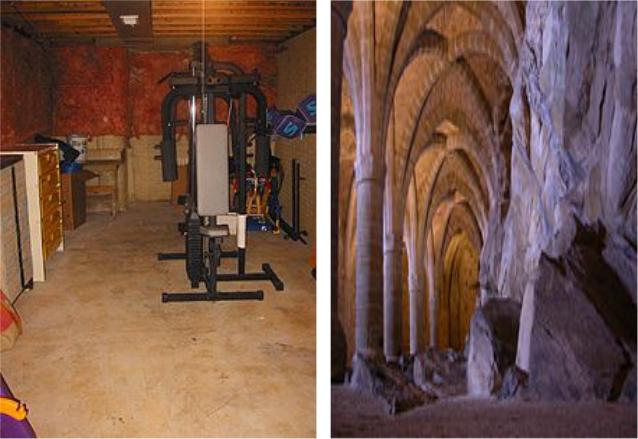
INTERIOR
Basement
A basement or cellar is one or more floors of a building that are either completely or partially below the ground floor. Basements are typically used as a utility space for a building where such items as the boiler, water heater, breaker panel or fuse box, car park, and air-conditioning system are located; so also are amenities such as the electrical distribution system, and cable television distribution point. However in cities with high property prices such as London, basements are often fitted out to a high standard and used as living space.
In British English, the word "basement" is used for underground floors of, for example, department stores, but the word is only used with houses when the space below their ground floor is habitable, with windows and (usually) its own
access. The word cellar or cellars is used to apply to the whole underground |
||||
level or to any large underground room (рис. 191–193). |
||||
|
|
|
|
И |
|
|
|
Д |
|
|
|
А |
|
|
|
б |
|
|
|
и |
|
|
|
|
С |
|
|
|
|
Рис. 191 |
Рис. 192 |
130

A basement can be used in almost exactlyИthe same manner as an
additional above-ground floor of a house or other building. However, the use of basements depends largely on factors specificДto a particular geographical area
such as climate, soil, seismic activity, building technology, and real estate economics. А
Basements in small buildings such as single-family detached houses are rare in wet climates such as GreatбBritain and Ireland where flooding can be a problem, though they may be used on larger structures. However, basements are considered standard on иall but the smallest new buildings in many places with temperate continental climates such as the American Midwest and the Canadian Prairies where a concreteСfoundation below the frost line is needed in any case, to prevent a building from shifting during the freeze-thaw cycle. Basements are much easier to construct in areas with relatively soft soils, and may be foregone in places where the soil is too compact for easy excavation. Their use may be restricted in earthquake zones, because of the possibility of the upper floors collapsing into the basement; on the other hand, they may be required in tornado-prone areas as a shelter against violent winds. Adding a basement can also reduce heating and cooling costs as it is a form of earth sheltering, and a way to reduce a building's surface area-to-volume ratio. The housing density of an area may also influence whether or not a basement is considered necessary.
Historically, basements have become much easier to build (in developed countries) since the industrialization of home building. Large powered excavation machines such as backhoes and front-end loaders have reduced the time and manpower needed to dig a basement dramatically as compared to digging by hand with a spade, although this method may still be used in the developing world.
131
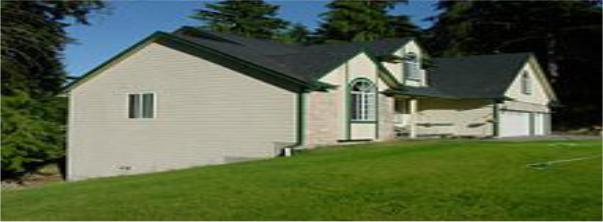
For most of its early history, the basement took one of two forms. It could be little more than a cellar, or it could be a section of a building containing rooms and spaces similar to those of the rest of the structure, as in the case of basement flats and basement offices.
However, beginning with the development of large, mid-priced suburban homes in the 1950s, the basement, as a space in its own right, gradually took hold. Initially, it was typically a large, concrete-floored space, accessed by indoor stairs, with exposed columns and beams along the walls and ceilings, or sometimes, walls of poured concrete or concrete cinder block.
Задание 1. Прочитайте и переведите текст. Подготовьте устное сообщение о типах цоколя, укажите основание вашей классификации.
Types of basementИ
a house situated on a slope, so that part of the floor is above ground, with a
doorway to the outside. The part of the floor lower than the ground can be
A daylight basement (рис. 194) or aД"walk-out basement" is contained in
Occupants can walk out at thatбpointАwithout having to use stairs. For example, if the ground slopes downwardsиtowards the back of the house, the basement is at or above grade (ground level) at the back of the house. It is a modern design because of the addedСcomplexity of uneven foundations; where the basement is
considered the true basement area. From the street, some daylight basement
homes appear to be one story. Others appear to be a conventional two story
home from the street (with the buried, or basement, portion in the back).
above grade, the foundation is deeper at that point and must still be below the frost line.
Рис. 194
132

Full-size windows can be installed in a daylight basement. These can provide exits for bedrooms (building bedrooms in basements is usually illegal without an outside escape). Ventilation is improved over fully buried basement homes, with less dampness and mold problems.
Daylight basements can be used for several purposes – as a garage, as maintenance rooms, or as living space. The buried portion is often used for storage, laundry room, hot water tanks, and HVAC.
Daylight basement homes typically appraise higher than standardbasement homes, since they include more viable living spaces. In some parts of the U.S. however the appraisal for daylight basement space is half that of ground and above ground level square footage. Designs accommodated include split-foyer and split-level homes. Garages on both levels are sometimes
possible. As with any multilevel home, there are savings on roofing and |
|
foundations. |
И |
|
|
In a "look-out" basement, the basement walls extend sufficiently above |
|
|
Д |
ground level that some of the basement windows are above ground level (см. рис. 195). Where the site slopes gently and is insufficient for a walk-out basement, a look-out basement tends to result. Sometimes, a look-out basement is deliberately constructed even onАa flat site. The advantage is that the basement windows are all above grade. The disadvantage is that the main floor entry is above grade as well, utilizingбstairs to access the main floor. The raised Bungalow design (known as a split-entry home in much of the US) solves this by lowering the entry halfwayиbetween the main floor and basement to make a dramatic, high-ceiling foyer. It is a very economical design because the basement is shallower,Сand excavation costs are reduced.
Рис. 195
133

Рис. 196 |
И |
|
|
A “walk-up” basement (рис. 196) is any basement that has an exterior |
|
А |
|
entrance via a stairwell. Some designs cover the stairwell with angled |
|
“basement doors” or "bulkhead doors" to keep rain water from accumulating in |
|
the stairwell. |
Д |
When initially built, the main floor joists are often exposed and the walls |
|
and floors concrete (withиinsulation,бwhere appropriate). Unfinished basements allow for easy access to the main floor for renovation to the main floor. Finishing the basementСcan add significant floor space to a house (doubling it in the case of a bungalow) and is a major renovation project.
According to the international Oxford Dictionary of English, a cellar (рис. 197) is a room below ground level in a house that is often used for the storage of wine or coal; it may also refer to the stock of wine itself. A cellar is intended to remain at a constant cool (not freezing) temperature all year round and usually has either a small window/opening or some form of air ventilation (air/draught bricks, etc.) in order to help eliminate damp or stale air. Cellars are more common in the UK in older houses, with most terraced housing built during late 19th, and early 20th century having cellars. These were important shelters from air raids during World War II. In parts of the U.S. that are prone to tornadoes, cellars still serve as shelter in the event of a direct hit on the house from a tornado or other storm damage caused by strong winds.
134
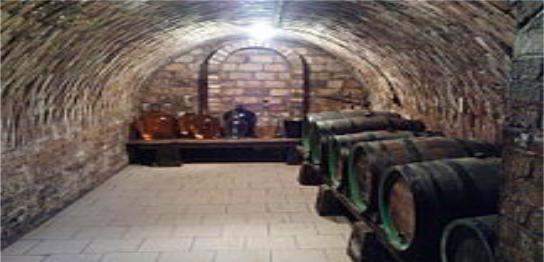
have no cellar or basement due to the extra cost of digging down further into
Except for Britain, Australia and New Zealand,Иcellars are popular in most western countries. In the UK, almostДall new homes built since the 1960s
the sub-soil and a requirement for much deeper foundations and waterproof
reason, especially where lofts haveАbeen converted into living space, people tend to use garages forиthe storage of food (e.g. in a freezer), tools, bicycles, garden and outdoor equipment. The majority of continental European houses have cellars, althoughСa large proportion of people live in apartments or flats rather than houses. In North America, cellars usually are found in rural or older homes on the coasts and in the South. However, full basements are commonplace in new houses in the US Midwest and other areas subject to tornado activity or requiring foundations below the frost line.
tanking. The reverse has recently become common, where the impact of smaller
home-footprints has led to roof-space being utilised for further living space and now many new homes are builtбwith third-floor living accommodation. For this
Crawl space. A crawl space (as the name implies) is a type of basement in
which one cannot stand up − the height may be as little as one foot, and the surface is often soil. Crawl spaces offer a convenient access to pipes, substructures and a variety of other areas that may be difficult or expensive to access otherwise. While a crawl space cannot be used as living space, it can be used as storage, often for infrequently used items. Care must be taken in doing so, however, as water from the damp ground, water vapour (entering from crawl space vents), and moisture seeping through porous concrete can create a perfect environment for mould/mildew to form on any surface in the crawl space, especially cardboard boxes, wood floors and surfaces, drywall and some types of insulation.
135
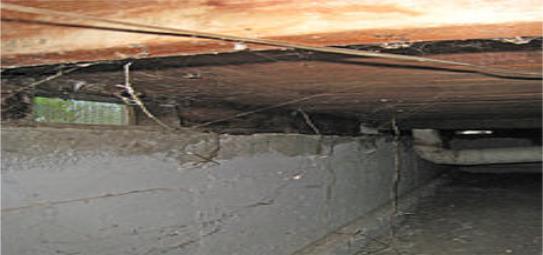
A typical crawl space showing Crawl space vents and concrete ratproofing. Rat-proofing is a thin, irregular concrete covering applied over the dirt to prevent rodents from burrowing under the foundation wall and entering the crawl space (рис. 198).
Рис. 198 |
И |
Health and safety issues must be Дconsidered when installing a crawl space. As air warms in a home, it rises and leaves through the upper regions of
the house, much in the same way that air moves through a chimney. This
phenomenon, called the "stack effect," causes the home to suck air up from the |
|
|
А |
crawl space into the main area of the home. Mould spores, decomposition |
|
odours, and fecal material fromбdust mites in the crawl space can come up with |
|
the air, aggravating breathing problems (such as asthma) and creating a variety |
|
of health-related problems.и |
|
It is usually desirable to finish a crawl space with a plastic vapour barrier |
|
that will not supportСmould growth or allow humidity from the earth into the crawl space. This helps insulate the crawl space and discourages the habitation of insects and vermin by breaking the ecological chain in which insects feed off the mould and vermin feed on the insects, as well as creating a physical inorganic barrier that deters entrance into the space. Vapour barriers can end at the wall or be run up the wall and fastened to provide even more protection against moisture infiltration. Some pest control agencies recommend against covering the walls as it complicates their job of inspection and spraying. Almost unheard of as late as the 1990s, vapour barriers are becoming increasingly popular in recent years. In fact, the more general area of conditioned vs. unconditioned crawl spaces has seen much research over the last decade.
136
